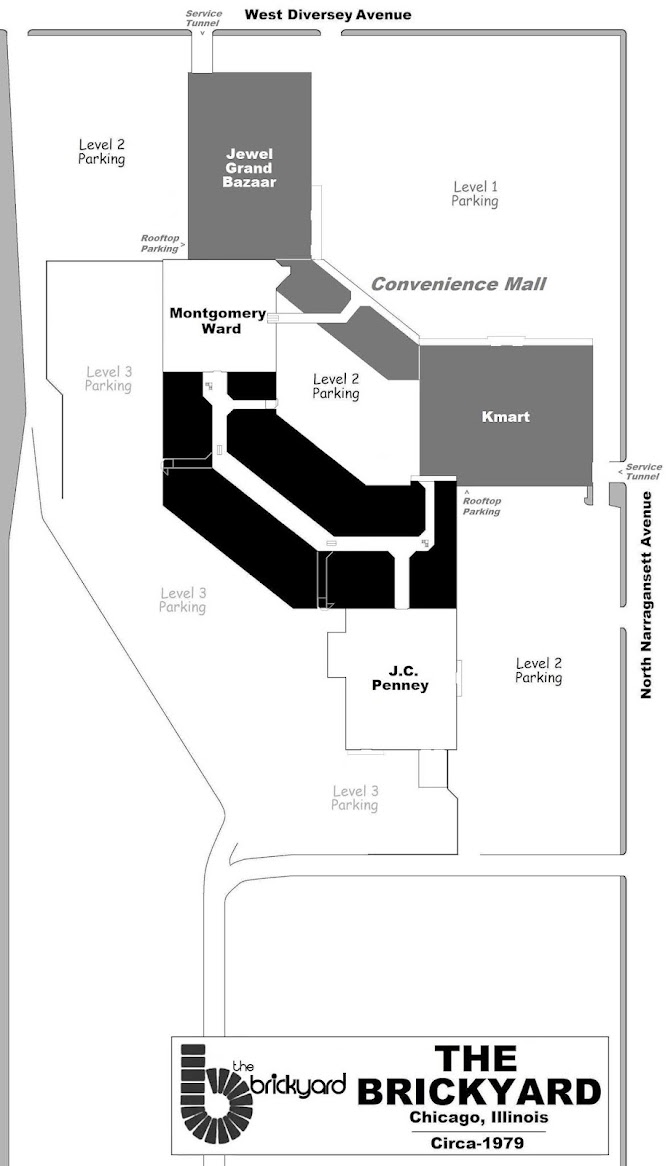CAREY BRICKWORKS
The Carey Brick Works thrived, producing 300 million Chicago common and street paver bricks yearly from the clay, creating a deep pit. The old brick kilns didn't meet modern environmental standards, and Carey Brick Works closed. Carey opened Chicago's Thunder Mountain Ski Resort in 1967, which boasted the longest vertical slope, 285 feet to the bottom of the clay pit, of any place within 200 miles.
THE BRICKYARD SHOPPING CENTER
In April 1975, plans for a Brickyard site shopping complex were announced. The ground was broken on September 17, with Mayor Richard J. Daley turning the first shovel of earth. A (250,000 sq. ft.) Convenience Mall was built. This was anchored by a single-level Jewel Grand Bazaar (90,400 sq. ft.), Osco Drug Center on the north, and a single-level Kmart on the southeast (118,700 sq. ft.).
Phases I and II of The Brickyard were designed by New York City's Edward M. Cohen and E.N. Maisel Associates. Phase I (the Convenience Mall) opened on March 16, 1977.
Twelve inline stores lined a single-sided, enclosed shopping concourse. These included Bresler's 33 Flavors, Page Two Card & Gifts, Gladan Jewelers, Ricky's West Restaurant, Fayva Shoes, Radio Shack and Fashion Action.
A 2-level, fully-enclosed mall was built to the southwest and on top of the Convenience Mall. This Phase II mall was anchored by a 2-level Montgomery Ward (180,000 sq. ft.) on the north and a 2-level JCPenney (190,800 sq. ft.) on the south. The Wards store and the new enclosed mall opened on March 1, 1979. JCPenney opened for business on July 11.
The Brickyard cost 50 million dollars to construct. The 3-level complex housed approximately 920,800 leasable square feet. Among its 117 stores were Richman Brothers, Claire's Boutique, Woman's World Shops, Susie's Casuals, The Orange Bowl snack bar, Joe Singer Shoes and Legion Magnavox.
There were several major retail centers in the vicinity. These included the Belmont-Central business district 1/2 mile northeast, in Chicago, Harlem Irving Plaza (1956) 2 miles northwest, in Norridge, North Riverside Park Mall (1976) 4.5 miles southwest, in North Riverside, and Lincolnwood Town Center (1990) 7 miles northeast, in Lincolnwood. Despite all the competition, The Brickyard was an astounding success in its early years.
The Brickyard site's southwestern and southern sectors were still undeveloped in 1983. They were acquired by the owner of the mall and cleared and graded. In December 1986, E.N. Maisel Associates sold The Brickyard to the Metropolitan Life Insurance Company.
The newly cleared land was developed with Bricktown Square, a 277,400 sq. ft. strip plaza. The open-air complex housed tenants such as Toys "R" Us, SportMart, a Fretter SuperStore and a 6-screen Cineplex Odeon Bricktown Square Cinema. This venue showed its first feature films on May 14, 1989.
During the demolition of the Brickyard, the Bricktown Square strip mall was left standing. The Brickyard was given an indoor-outdoor facelift in the early 1990s. Mall entrances were rebuilt, and a food court was installed. The Brickyard Mall was the new name of the Brickyard Center, and a new logo was created.
A refurbished Kmart reopened as a Big Mart on April 23, 1997. This was the Michigan-based chain's first Big Kmart conversion. Unfortunately, this store remodeling was not enough to stave off the impending decline of the mall. By 1998, it was in a downward spiral exacerbated by an anchor store exodus.
Big Kmart closed in the summer of 2000, Montgomery Ward left in February 2001, and JCPenney, which had been demoted to an Outlet Store in April 1999, was shuttered in April 2001. These three anchor stores were never leased again. Jewel-Osco remained as the mall's only major operational store.
By late 2002, New York City's Whitehall Street Real Estate had acquired the "functionally obsolete" shopping mall, deciding that total demolition was in order.
A joint venture was formed with the Illinois-based Mid-America Real Estate Corporation.
The mall complex was bulldozed in December 2002. Jewel-Osco was temporarily left standing until a new store could be built. The Bricktown Square strip center was also left intact.
A 40-million-dollar plaza, known as The Brickyard, was built. Its first phase, including a new 64,200 sq. ft. Jewel-Osco, opened for business in March 2004. Phase II of the 551,000 sq. ft. complex featured a Target and a Lowe's store. Target's grand opening was held on October 10, 2004. At the same time, the Illinois-based Inland Real Estate Investment Group acquired the new and improved Brickyard.
Compiled by Dr. Neil Gale, Ph.D.









Very interesting!
ReplyDelete